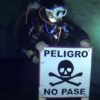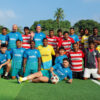The following webinars are available free online throughout 2017 and are organised by Bob Willis for NPL. A direct link is provided for each event to allow you to book online
Characterisation of High Temperature Component Interconnect Materials
Martin Wickham – National Physical Laboratory
Tuesday 10th January
To book you place https://attendee.gotowebinar.com/register/576076302374551811
The UK’s National Physical Laboratory is being partnered with several end-users to better characterise alternatives for high temperature component interconnect to operate above 200oC. Currently, for electronic assemblies to operate at high temperature, they must use a high lead solder or expensive gold based solder. NPL has been part of a consortia to successfully develop innovative materials specifically designed to offer a Pb-free cost effective alternative.
This presentation summarises the work undertaken by the authors to develop and better understand this new family of electrical interconnection materials including updated long-term reliability data. The project brought together a materials supplier (GEM – Gwent Electronic Materials), an end-user (MSL – Microsemi) and a technology research organisation (NPL – National Physical Laboratory) to jointly develop, test and implement in production, the solution based on silver-loaded silicone materials. This presentation focuses on the testing and materials evaluation undertaken at NPL to determine the long term performance of these alternative materials including high temperature ageing up to 300oC, thermal cycling and damp heat testing. Details of the shear strength and electrical performance of interconnects between the substrates and components during the test regimes are given. The manufacturing process is outlined including details of the test vehicles utilised. The processing temperature for the conductive adhesive is 250oC which offers additional advantages in potential improvements in component and substrate reliability compared to soldered solutions which would typically be processed at temperatures above 300oC
Topics covered include
High temperature materials and applications
Development of materials for HT
Reliability results from two projects
Long term high temperature storage and mechanical testing
Design issues and process failures
Future requirements and testing
The webinar will run for between 45-60min with question and answer session. The webinars are limited to 100 delegates/companies. A copy of each of the slides presented and links to NPL reports will be provided after the webinar
Techniques for the Characterisation of Printed Electrodes & Sensor Materials
Martin Wickham
Tuesday 14 March
To book your place https://attendee.gotowebinar.com/register/7040319566887712771
The ability to characterise printed electrode and sensor materials is important in both determining the best formulations for the intended purpose and also to understand how the fabrication process which can lead to differing electrode responses. A range of techniques have been used at NPL to characterise printed inks in order to understand material behaviour, and manufacturing variables. The combination of all these techniques allows sensor and electrode materials to be characterised and modified according to specific needs
The techniques described are based on:
Electrochemical Techniques, including
Electrochemical Impedance Spectroscopy (EIS)
Cyclic Voltammetry (CV)
Surface Characterisation Techniques including
Scanning Electron Microscopy (SEM)
3D Microscopy and Contact Angle measurements
The webinar will run for between 45-60min with question and answer session. The webinars are limited to 100 delegates/companies. A copy of each of the slides presented and links to NPL reports will be provided after the webinar
UV Inspection and Thickness Measurement of Conformal Coatings
Tuesday 9 May
Vimal Gopee
To book your place https://attendee.gotowebinar.com/register/7276933369673661443
The lifetime and reliability of electronics made to operate in harsh environments can be enhanced by conformal coatings applications. These polymer based coatings provide a barrier to air-borne contaminants from the operating environment thus preventing attack from moisture, aggressive chemicals, salt sprays, etc. The protection of discrete components mounted on PCBs, such as resistors, capacitors, packages and passive components, can be achieved by the application of conformal coating using methods such as dipping, selective robot coating, spraying and brushing.
Conformal coating should completely cover the assembly and provide a good cover of sharp edges and other contours. There are however no reliable non-destructive methods for monitoring the coating thicknesses on common problem areas on PCBs. We will discuss a novel, non-destructive, UV inspection system, capable of measuring the conformal coating thicknesses on step edges of components
Topics covered
Conformal coatings for the protection of electronic circuits – a brief introduction
Common conformal coatings and Application methods
Common issues with conformal coatings
A review of common methods for conformal coating thickness measurements
Using UV tracers for monitoring conformal coating thicknesses
The theory behind UV tracers for thickness monitoring
Experimental methods and materials
Equipment design
Results and discussions
Conclusions and future work
The webinar will run for between 45-60min with question and answer session. The webinars are limited to 100 delegates/companies. A copy of each of the slides presented and links to NPL reports will be provided after the webinar
Electrical Performance of Organic Substrate Materials and Coatings Aged at High Temperature
Adam Lewis, Christine Thorogood & Martin Wickham
Tuesday 11th July
To book your place https://attendee.gotowebinar.com/register/5965151126550980867
In this presentation, we will discuss the evaluation of the performance of substrate materials and coatings to determine their suitability for operation in high temperature environments
PCB materials with Surface Insulation Resistance (SIR) test patterns were aged at 250 °C for over 2000 hours. During this test, the SIR and capacitance was monitored both along the surface and throughout the board at various locations. The effect on the ageing process on the dielectric breakdown strength of high temperature ageing on PCB materials and efficacy of protective coatings has been evaluated and is discussed. Optical inspection of micro-sections gave information regarding the oxygen permeation through the materials during the ageing process
Topics covered
Substrates materials
High temperature environments
Surface insulation & capacitor measurement
Impact of high temperature on coating materials
Microsection analysis
The webinar will run for between 45-60min with question and answer session. The webinars are limited to 100 delegates/companies. A copy of each of the slides presented and links to NPL reports will be provided after the webinar
Electrical Metrology for Flexible & Printed Electronics
Dr Adam P. Lewis
Tuesday 12 September
To book your place https://attendee.gotowebinar.com/register/503638276872171010
The printed electronics market doubled from 2014 to 2015 and a similar growth has been predicted for 2016. To ensure high yield and reduced wastage, the development of metrology to evaluate the electrical properties and quality of printed devices is required. This method will need to be high speed and therefore non-contact in order to keep up with the manufacturing process. In this presentation, along with a discussion on metrology options for the printed electronics community, we will discuss the development of our solution for high speed, non-contact electrical metrology of printed electronics
Topics covered
Introduction to us of printed electronics
Practical applications
Non-contact measurements of sheet resistivity
Comparison with alternative metrology options
Sensor optimisation for wide range of ink technologies
The webinar will run for between 45-60min with question and answer session. The webinars are limited to 100 delegates/companies. A copy of each of the slides presented and links to NPL reports will be provided after the webinar
Condensation Failure & Improved Testing for Electronic Assemblies
Ling Zou
Tuesday 14 November
To book your place https://attendee.gotowebinar.com/register/5359964532967995394
NPL has developed a new test method to control the rate of condensation on to printed board assemblies during environmental testing. The method provided considerable improvements on existing industry standard tests and NPL’s Electronics Interconnection Group is currently running a multi-partner project to refine the test and fine criteria. This webinar provided an overview of the test methods and some results from other NPL SIR assessment projects in Europe.
Topics covered:
Review of existing test methods
Disadvantages of industry procedures
NPL condensation test benefits
Results of selected production trials
The webinar will run for between 45-60min with question and answer session. The webinars are limited to 100 delegates/companies. A copy of each of the slides presented and links to NPL reports will be provided after the webinar


